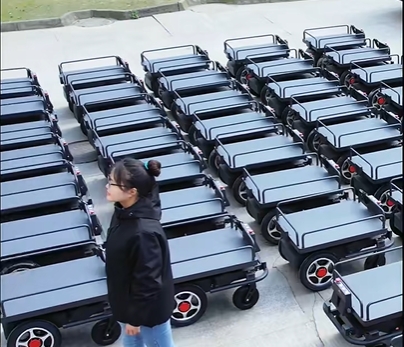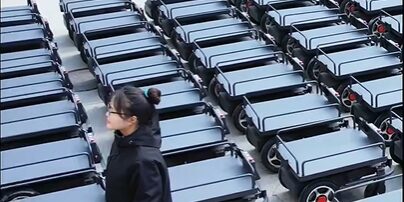In a world where efficiency and convenience are paramount, Autonomous Follow Robots (AFRs) are leading the charge in transforming industries across the globe. From factories to shopping malls, these intelligent robots are making life easier, faster, and more efficient. But what exactly are Autonomous Follow Robots, and why should businesses care about them?
In this blog, we will dive deep into the key applications of AFRs, showing how they can revolutionize various sectors. We’ll also explore the benefits of integrating these robots into your workflow, ultimately boosting productivity and transforming how work gets done.

What are Autonomous Follow Robots (AFRs)?
Autonomous Follow Robots are intelligent machines designed to follow people or objects automatically. They use a combination of sensors, cameras, and advanced algorithms (including LiDAR technology) to navigate environments, follow paths, and even avoid obstacles. Unlike traditional robots that require manual control, AFRs operate autonomously and can adapt to changing environments, making them ideal for tasks that require frequent movement, like material handling or delivery.
These robots are also capable of interacting with their environment in real-time, providing features like obstacle avoidance, automatic pathfinding, and even real-time notifications if something goes wrong. Now, let’s explore the various ways in which AFRs are being used across industries.
1. Streamlining Factory Operations: From Manual Labor to Smart Efficiency
Factories and manufacturing facilities have long been at the forefront of automation. However, there’s always room for improvement. Traditionally, factory workers have relied on hand-pushed carts to move materials and tools around. This can be physically demanding, time-consuming, and prone to human error.
With AFRs, these tasks are automated. These robots can follow workers as they walk around the factory floor, transporting tools, materials, or even finished products. This significantly reduces the need for manual labor and boosts overall productivity. AFRs are particularly useful in factories with large spaces or complex layouts, where frequent movement of materials is required.
The benefits? Less physical strain on employees, fewer chances for human error, and most importantly, increased overall production efficiency.
2. Enhancing Warehouse and Logistics Operations
In the world of logistics, speed and efficiency are crucial. Managing inventory, moving products from one location to another, and maintaining streamlined workflows are all vital to success. However, handling all these tasks manually can slow things down.
This is where AFRs come in. In warehouses, these robots can follow warehouse workers to transport goods and materials, improving the efficiency of stock picking and order fulfillment. Since AFRs can operate autonomously, they can work continuously without the need for breaks, making them ideal for high-demand environments.
They also support dynamic movement, meaning they can change their path or stop to avoid obstacles on the fly. This adaptability makes AFRs a great solution for warehouses with high traffic and constantly shifting layouts.

3. Agriculture 4.0: Automation in Greenhouses and Farms
Agriculture may not be the first industry that comes to mind when thinking about automation, but it’s rapidly becoming one of the most innovative. Farms and greenhouses are starting to embrace technology that can reduce labor and improve crop management. AFRs are a perfect fit for these needs.
In agriculture, AFRs can assist with transporting tools, soil, water, or even crops from one place to another. They help farmers focus on more complex tasks while the robots handle repetitive and physically demanding jobs. Whether it’s moving heavy sacks of fertilizer or helping with planting tasks, AFRs are making life easier for workers and allowing them to focus on higher-level responsibilities.
Moreover, the ability of AFRs to follow workers through large spaces, without requiring constant supervision, helps speed up operations, saving valuable time and reducing costs.
4. Revolutionizing Shopping Experiences: Smart Carts in Supermarkets and Malls
Retail is all about improving customer experiences, and AFRs are playing a huge role in this. Picture this: you walk into a supermarket or shopping mall, and an AFR follows you around, carrying your shopping cart or basket. You don’t have to worry about pushing it around or keeping track of it. It simply follows you, making shopping easier and more convenient.
This technology is particularly beneficial in crowded environments, where customers might find it difficult to navigate or manage a cart. With AFRs, retailers can offer a futuristic and customer-centric experience, improving satisfaction and increasing engagement.
Additionally, for mall managers, AFRs can be programmed to provide directions or even assist with deliveries, adding an extra layer of service for shoppers.
5. Transforming Residential Areas: Smart Assistance for Everyday Tasks
From moving tools around neighborhoods to transporting luggage at airports, AFRs are improving everyday tasks that were once tedious or time-consuming. For residential areas, AFRs can be used for services like delivering mail, carrying groceries, or even helping with lawn care.
These robots are especially beneficial in environments where long distances need to be covered or when people have limited mobility. Imagine a scenario where your luggage follows you through the airport, or your groceries are carried from your car to your door automatically.
In gated communities or parks, AFRs can assist with deliveries, transport materials, or even carry heavy equipment to where it’s needed most. These smart robots save time and labor, contributing to a more streamlined and efficient community.
6. Personal Assistance: Smart Devices for Everyday Comfort
We’re all familiar with devices that make life easier—smartphones, voice assistants, and even smart speakers. But what about smart personal assistants that follow you around and help with daily tasks? AFRs are bringing this idea to life.
Personal AFRs can carry luggage, golf bags, and even assist with mobility issues, such as helping people in wheelchairs or other mobility aids. These robots are particularly useful for individuals with disabilities or those who simply want to make their daily routines more convenient.
Not only do these robots help transport personal belongings, but they also promote independence and mobility, making everyday life just a little bit easier.
7. Multi-Robot Follow Systems: Tackling Complex Tasks
One of the standout features of AFRs is their ability to operate as part of a multi-robot system. This means several AFRs can work together, following a group of people or coordinating tasks within a larger operation. In industrial settings, this can include large-scale delivery systems, managing complex materials handling tasks, or assisting with multi-location operations.
By working in tandem, these robots can support a variety of complex tasks, ensuring smooth operations even in the busiest environments. This collaborative behavior is particularly valuable for large organizations or industries that rely on high efficiency and seamless coordination.
Conclusion: The Future of AFRs is Now
As you can see, Autonomous Follow Robots are not just a passing trend—they’re a game-changing solution that’s revolutionizing a wide range of industries. From streamlining factory operations to enhancing customer experiences, AFRs are proving to be indispensable in today’s fast-paced world.
Are you ready to take your operations to the next level?
If you’re looking for cutting-edge LiDAR technology and reception robots, CPJROBOT is your go-to partner. With expertise in manufacturing LiDAR solutions and advanced reception robots, we offer tailor-made solutions to suit your business needs. Whether it’s boosting your warehouse efficiency or creating a unique customer experience, CPJROBOT is committed to bringing the future of automation to you.
Let’s start building a smarter, more efficient future together. Reach out to CPJROBOT today!






